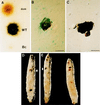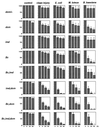Analysis of the Drosophila host defense in domino mutant larvae, which are devoid of hemocytes
- PMID: 9826701
- PMCID: PMC24374
- DOI: 10.1073/pnas.95.24.14337
Analysis of the Drosophila host defense in domino mutant larvae, which are devoid of hemocytes
Abstract
We have analyzed the Drosophila immune response in domino mutant larvae, which are devoid of blood cells. The domino mutants have a good larval viability, but they die as prepupae. We show that, on immune challenge, induction of the genes encoding antimicrobial peptides in the fat body is not affected significantly in the mutant larvae, indicating that hemocytes are not essential in this process. The hemocoele of domino larvae contains numerous live microorganisms, the presence of which induces a weak antimicrobial response in the fat body. A full response is observed only after septic injury. We propose that the fat body cells are activated both by the presence of microorganisms and by injury and that injury potentiates the effect of microorganisms. Survival experiments after an immune challenge showed that domino mutants devoid of blood cells maintain a wild-type resistance to septic injury. This resistance was also observed in mutant larvae in which the synthesis of antibacterial peptides is impaired (immune deficiency larvae) and in mutants that are deficient for humoral melanization (Black cells larvae). However, if domino was combined with either the immune deficiency or the Black cell mutation, the resistance to septic injury was reduced severely. These results establish the relevance of the three immune reactions: phagocytosis, synthesis of antibacterial peptides, and melanization. By working in synergy, they provide Drosophila a highly effective defense against injury and/or infection.
Figures




References
-
- Boman H G. Annu Rev Immunol. 1995;13:61–92. - PubMed
-
- Hoffmann J A, Reichhart J M, Hetru C. Curr Opin Immunol. 1996;8:8–13. - PubMed
-
- Hoffmann J A, Reichhart J M. Trends Cell Biol. 1997;7:309–316. - PubMed
-
- Fehlbaum P, Bulet P, Michaut L, Lagueux M, Broekaert W F, Hetru C, Hoffmann J A. J Biol Chem. 1994;269:33159–33163. - PubMed
Publication types
MeSH terms
Substances
LinkOut - more resources
Full Text Sources
Molecular Biology Databases

